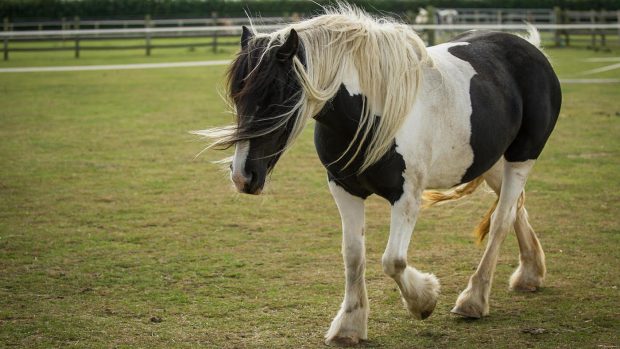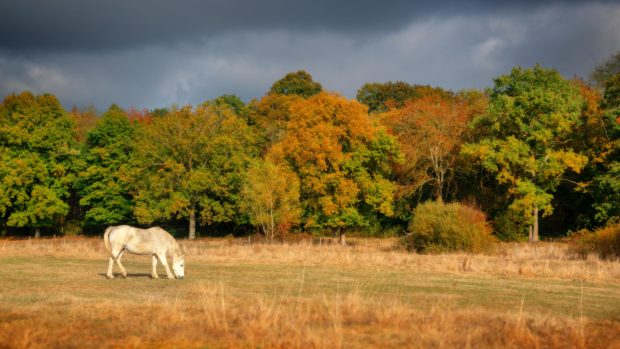Opinion
I was disappointed to read some negative comments on social media recently about a pony looking “unhappy” wearing a grazing muzzle. The pony had lost lots of weight – and I really take my hat off to the owner, losing weight is not an overnight task and it takes a lot of dedication – so to see negative comments about this fantastic achievement is so disheartening.
Laminitis is an emotive subject – and perhaps even more so is the topic of weight. Vets, farriers and welfare charities are working hard to support owners with information and advice, but as owners, we also need to do our bit. This might be taking advice on trimming or shoeing, or making adjustments to the management of our horses – which can be hard when we have managed them in a certain way previously.
My first experience of laminitis was as a child with my first pony Phoenix. He had suffered laminitis in the past and we knew when taking him on we would have to watch his weight carefully. One summer he came down with a mild case and I remember being so upset that my pony had got ill. He made a full recovery, and during the seven years I had him it was only one occurrence, but it was something that stayed with me.
Now as an owner of two miniature Shetlands, Mootie and Poppet, laminitis is always on my radar. They regularly wear grazing muzzles in summer – and sometimes winter too – and when they are not wearing their muzzles, they are in a bare paddock with some hay. They thankfully have never had laminitis but I know I cannot take my eye off the ball, no matter what time of year.
And that’s what made my Connemara/Irish sport horse mare Chloe developing acute laminitis in November 2019 a bitter pill to swallow. I turned her out one morning looking like her normal self, but when I took her in that evening, she was extremely uncomfortable and had a very “typical” laminitic stance. I got the vet, and before she could say the words, I knew Chloe had come down with laminitis.
I didn’t think Chloe, who was then seven, was particularly overweight and with winter ahead I thought we had time for her to lose some pounds before spring. I can’t help but think, could it have been prevented if she had been slimmer, and was this a failure on my part? She spent four weeks on box rest, on a lot of pain medication and she had regular trims from my farrier, which were difficult given how uncomfortable she was – but absolutely key to her recovery.
With time, hard work from my farrier and a huge amount of support from my vet, Chloe made a full recovery. But it was a harsh reality and some real lessons were learnt on my part. Now Chloe wears a muzzle when necessary, and perhaps the biggest thing has been having regular discussions with my farrier and vet about her weight. Those tricky conversations are no longer tricky and for me are so important to keeping her on the right track.
Our journey certainly wasn’t easy – and of course there are no guarantees it will never occur again, which is frightening. So more than ever I feel for owners who are dealing with horses and ponies with laminitis, or trying to help their animals lose weight. We all want our horses to be healthy and happy. But when we are talking about laminitis in overweight horses and ponies, we have to accept that preventative actions aren’t always going to be rosy. Grazing muzzles, diets, and restricted grazing can sound “mean”, for want of a better word, but I wholeheartedly agree with British Equine Veterinary Association president Lucy Grieve that “Food restriction is not as cruel as laminitis. Being clipped out and not wearing a rug is not as cruel as laminitis.”
Of course there are other preventative measures that people can take; track systems are being recommended more and I’ve seen some really fantastic set-ups. But we have to remember a track isn’t always possible at home, or at a livery yard. Using a grazing muzzle isn’t a lazy option or a quick fix, sometimes it’s a necessity. If owners are taking steps to prevent laminitis, or reduce their horses’ and ponies’ weight then they should be congratulated, not made to feel they are being cruel. While in a dream scenario I would love to see my mares grazing carefree on lush green fields, the reality is that could kill them, so for me it’s muzzles for the win.
No one has said laminitis is a simple condition; we know it can occur for a multitude of reasons such as PPID, equine metabolic syndrome, even stress.
Article continued below…

‘Reluctance and ignorance can mean signing horses’ death warrants’: top vet busts laminitis myths
“Food restriction is not as cruel as laminitis. Being clipped out and not wearing a rug is not as cruel

Changing conversations to save equine lives *H&H Plus*

Subscribe to Horse & Hound this spring for great savings
My thoroughbred gelding Archie developed laminitis when he was in hospital with an infection and being treated with steroids. He never came home from the hospital and I lost him to toxaemia – and while laminitis played a part, the outcome wasn’t anyone’s fault. Some cases sadly can’t be prevented – but in the cases of overweight horses and ponies this is something we can be proactive about.
While it’s great to see people discussing horse welfare and sharing tips with each other online, we can’t ignore expert advice. Vets and farriers aren’t pointing fingers and blaming owners – but they are there, with years of training, to look out for the welfare of animals. Vets are sometimes unfairly accused of “money grabbing” yet if we choose to ignore what they tell us about obesity and management, then surely that’s a surefire way of paying more vet bills, when we are calling them out to treat a case of laminitis?
Horse & Hound magazine, out every Thursday, is packed with all the latest news and reports, as well as interviews, specials, nostalgia, vet and training advice. Find how you can enjoy the magazine delivered to your door every week, plus options to upgrade to access our H&H Plus online service which brings you breaking news as it happens as well as other benefits.





